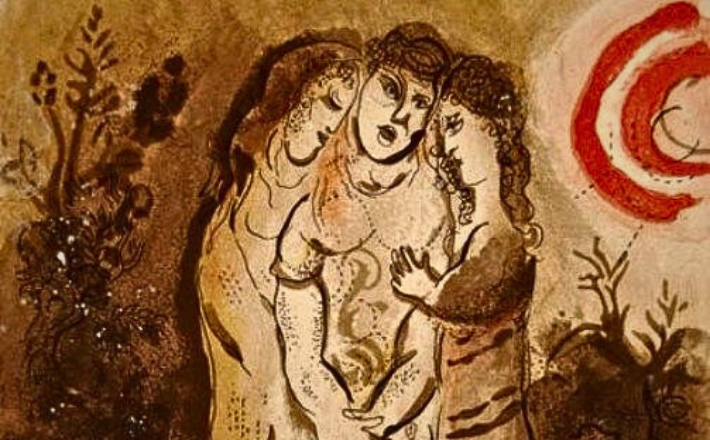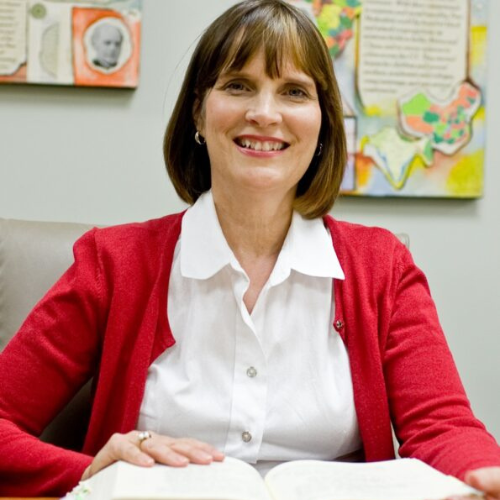Commentary on Ruth 1:1-17
“Do not press me to leave you or to turn back from following you!
Where you go, I will go; where you lodge, I will lodge,
Your people shall be my people, and your god my god.
Where you die, I will die—there will I be buried.
May the Lord do thus and so to me, and more as well, if even death parts me from you!”
Ruth 1:16-17
So says the Moabite Ruth to her Judahite mother-in-law, Naomi, vowing unspoken curses on herself if she fails to keep her promises. The first geographic setting for the story of Ruth is her homeland, Moab, across the Jordan from what became Israel. Last week we saw that Moses give the sermons of Deuteronomy in Moab, but he also died and was buried there (Deuteronomy 1:5, 29:1, 32:49, 34:1-5, 34:6-8). This well-known story is about how a non-Israelite woman became a model of faith, loyalty, and preserving life for all receivers of Scripture.
Less well known is the fact that the book of Ruth is part of the Writings, the third division of the Hebrew Bible, which follows the Torah and Prophets to comprise the Hebrew Bible, whose order preceded that of Greek and English Bibles. Most of the books of the Writings were produced in the Second Temple period, the time of Ezra and Nehemiah, when many Jews who had been exiled to Babylon were allowed to return to their land and encountered “women of the land,” whom many of the exiles married. The Greek Bible places Ruth after the book of Judges, for it occurs “in the day the judges ruled” (Ruth 1:1). English Bibles follow this ordering.
The setting of Ruth during the Judges period is significant, but so is the fact that it was likely produced during the time of Ezra and Nehemiah to address a social issue for the returned exiles: intermarriage. The book of Ruth challenges previously exiled Jews to remember their obligation to the stranger, the outsider, and the universality of the covenant God made with Abraham (Genesis 12:1-3). In their struggle with the social issue of “intermarriage,” post-exilic leaders, having learned the dangers of idolatry and its potential connection to exogamy (intermarriage), emphasized the need for endogamy, or marrying other Jews. Ezra attempted to expel the indigenous wives of returned exiles, calling them “strange,” or “foreign.” These wives could have been descendants of Jews who were left behind to tend the land, or those from unions of such Jews and others, because neighboring nations had been brought into the land of Judah during the Judahite exile to Babylon (Ezra 10:1-17). Ezra 10 concludes by listing officials who had married women of the land, not their expulsion. Ezra 10:44 is not in the Hebrew Bible.
Ruth counters this trend toward exclusivism by reminding the post-exilic community of the faithful outsider women in Israel’s story. The book of Ruth explicitly recalls not only the Moabite Ruth but also Tamar, who became a matriarch of the royal tribe of Judah, to which Naomi’s family belonged. Let’s see how this unfolds.
At the beginning of the story, we learn that Naomi was a widow, and more than a widow—she was an almanah, for she had also lost her sons, so was utterly bereft of males to support her. Then and now, widows symbolize bereavement, poverty, and dependence, and are often without adequate means to live—especially if, like Naomi and Ruth, they had no sons. Naomi and Ruth—two widows, the younger a Moabite! Naomi felt utterly deprived, but she was not—for she had Ruth, a Moabite daughter-in-law who loved her. Ruth refused to let Naomi travel back to Bethlehem alone—in the frightful tribal era, about which the book of Judges says: “all the people did what was right in their own eyes!” We know this was utter chaos, violence, and degeneration.
Ruth became a model for later converts, by following her mother-in-law back to Judah out of loyalty and love. This was not in her best interest, as is made clear by Naomi’s rationale for urging her to turn back to Moab. But Ruth clung to Naomi like glue (1:14). She promised six things to Naomi: they will journey together, live together, share a common people, share a common God, die in the same place and be buried in the same location, perhaps in the same family tomb.
We may not realize how much of an outsider Ruth was to the early audiences of this drama.
Israel’s story of Moab’s origins disparages them. In Genesis 19, we learn that the nations of Moab and Ammon descended from the sons of Lot and his daughters, who feared they could never have children any other way after surviving the destruction of Sodom. Throughout much of their history (not all), Moab was Israel’s enemy. The legal ruling against these nations proscribes any “Ammonite or Moabite [to] be admitted to the assembly of the Lord. Even to the tenth generation … ” (Deuteronomy 23:3).
As Ruth ultimately married Boaz, a kinsman of Naomi’s husband, all the people at the gate said: “We are witnesses. May the Lord make the woman who is coming into your house like Rachel and Leah … and, through the children that the Lord will give you by this young woman, may your house be like the house of Perez, whom Tamar bore to Judah” (Ruth 4:11–12). This points to another outsider woman, the Canaanite, Tamar, who pretended to be a prostitute in order to bear progeny. After Ruth gave birth to Obed, the women affirmed that Naomi was not an almanah, an utterly bereft one without a redeemer. “Obed shall be to you a restorer of life and a nourisher of your old age; for your daughter-in-law who loves you, who is more to you than seven sons, has borne him!” (Ruth 4:14-15). More than seven sons! Throughout Scripture the perfect family has seven sons and three daughters (Job 42:12-15) and yet this Moabite foreigner is worth more to Naomi than seven Jewish sons! Outrageous!
The story of Ruth also reminded Jews that their great king, David, and all the kings of Judah since, descended from a faithful Moabite woman; that women who joined the people of God should be emulated, not expelled, whatever their background. Like many other Old and New Testament passages (Exodus 4, Joshua 2, 2 Samuel 11, Acts 10:34-5, Romans 2:14-5), it shows us that loyalty and faithfulness includes us among God’s people, not biology, genetics, culture, or history.
PRAYER OF THE DAY
God of the people, your servant Ruth showed great love when she clung to Naomi. Teach us to show great compassion, and to turn to you when we are in need. Amen.
HYMNS
I will trust in the Lord NCH 416, UMH 464, TFF 256
Come, thou fount of every blessing ELW 807, GG 475, H82 686, UMH 400, NCH 459, TFF 108
Baptized in Water ELW 456, GG 482, H82 294
For All the Faithful Women ELW 419, GG 324, TFF 219
CHORAL
Entreat me not to leave you, Dan Forrest


October 15, 2023